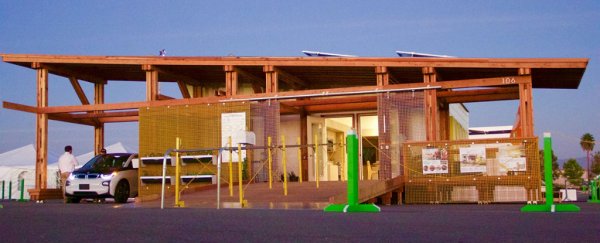University students in the US have designed a revolutionary new type of building called the Indigo Pine, which is powered entirely by its rooftop solar panels and can be put together from wooden pieces like a jigsaw. And the best part is the plans for the house can be sent over email, allowing anyone to build their own Indigo Pine wherever they live.
Of course, you can't actually email building materials and solar panels, but the template is simple and universal enough to be downloaded and used almost anywhere: the main material you'll need to source locally is CNC-milled plywood. The home is carbon neutral and can be constructed by hand.
That ease of construction is down to a system the Clemson University students call Sim[PLY]. It's founded on a set of digital design files that can then be sent to a local CNC (Computer Numerical Control) machine - at the end of the cutting process you're left with over 500 pieces of plywood that can be flat-packed and shipped to a site. The pieces fit together like an elaborate jigsaw, with no fastening materials needed except for some stainless steel bands during construction and some holding screws in the floor joists.
The house was invented as part of the Solar Decathlon competition, which is hosted by the US Department of Energy and the National Renewable Energy Laboratory (NREL), and asks students to imagine solar-powered homes that are "cost-effective, energy-efficient, and attractive".
"The repetition and adjustment of building units within the system create an expandable and customisable structure," the Indigo Pine team explains. "All information is embedded within the pieces, eliminating the need for on-site measuring and cutting, which allows for fast and efficient construction."
What the proud new homeowner ends up with is a 300 metre squared house with three bedrooms, bathrooms, a large common space with kitchen, a front porch, and a car port. The highly efficient photovoltaic panels drive a solar-powered hot water system inside the building, while airflow underneath the building helps to regulate temperatures inside.
Two Indigo Pine homes have now been built, one of which will take part in the Solar Decathlon challenge against other colleges and universities. The students behind the design say it could one day be developed to be sent anywhere in the world, constructed using local materials, adapted to specific site requirements, and influenced by local culture.
"The entire concept behind the Sim[PLY] structural system is a quicker, better, safer house construction (not to mention the sustainable aspects of flat-packed parts and local fabrication sourcing)," explains the Indigo Pine blog. "The rapid construction time allows for the construction of two homes in the time it takes for construction of one home with traditional methods."
Indigo Pine is just a student project for now - but the ideas behind it could well end up influencing construction methods in the years to come.

